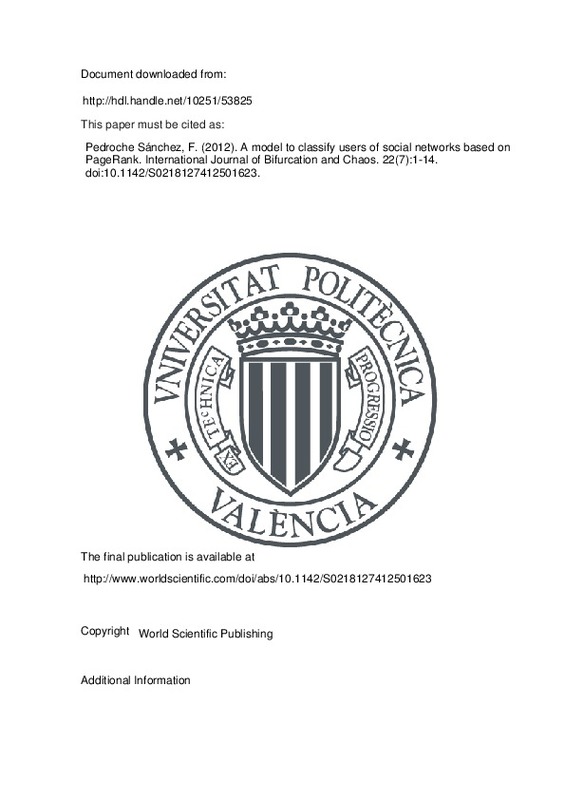Arenas, A., Díaz-Guilera, A., Kurths, J., Moreno, Y., & Zhou, C. (2008). Synchronization in complex networks. Physics Reports, 469(3), 93-153. doi:10.1016/j.physrep.2008.09.002
BOCCALETTI, S., LATORA, V., MORENO, Y., CHAVEZ, M., & HWANG, D. (2006). Complex networks: Structure and dynamics. Physics Reports, 424(4-5), 175-308. doi:10.1016/j.physrep.2005.10.009
Boldi, P., Santini, M., & Vigna, S. (2009). PageRank. ACM Transactions on Information Systems, 27(4), 1-23. doi:10.1145/1629096.1629097
[+]
Arenas, A., Díaz-Guilera, A., Kurths, J., Moreno, Y., & Zhou, C. (2008). Synchronization in complex networks. Physics Reports, 469(3), 93-153. doi:10.1016/j.physrep.2008.09.002
BOCCALETTI, S., LATORA, V., MORENO, Y., CHAVEZ, M., & HWANG, D. (2006). Complex networks: Structure and dynamics. Physics Reports, 424(4-5), 175-308. doi:10.1016/j.physrep.2005.10.009
Boldi, P., Santini, M., & Vigna, S. (2009). PageRank. ACM Transactions on Information Systems, 27(4), 1-23. doi:10.1145/1629096.1629097
Clauset, A., Shalizi, C. R., & Newman, M. E. J. (2009). Power-Law Distributions in Empirical Data. SIAM Review, 51(4), 661-703. doi:10.1137/070710111
Criado, R., Flores, J., González-Vasco, M. I., & Pello, J. (2007). Choosing a leader on a complex network. Journal of Computational and Applied Mathematics, 204(1), 10-17. doi:10.1016/j.cam.2006.04.024
C. De Kerchove and P. Van Dooren, Lectures Notes in Control and Information Sciences 389 (2009) pp. 3–16.
Dorogovtsev, S. (2010). Lectures on Complex Networks. doi:10.1093/acprof:oso/9780199548927.001.0001
Easley, D., & Kleinberg, J. (2010). Networks, Crowds, and Markets. doi:10.1017/cbo9780511761942
Estrada, E., & Higham, D. J. (2010). Network Properties Revealed through Matrix Functions. SIAM Review, 52(4), 696-714. doi:10.1137/090761070
Fortunato, S. (2010). Community detection in graphs. Physics Reports, 486(3-5), 75-174. doi:10.1016/j.physrep.2009.11.002
Granovetter, M. S. (1973). The Strength of Weak Ties. American Journal of Sociology, 78(6), 1360-1380. doi:10.1086/225469
Haveliwala, T. H. (2003). Topic-sensitive pagerank: A context-sensitive ranking algorithm for web search. IEEE Transactions on Knowledge and Data Engineering, 15(4), 784-796. doi:10.1109/tkde.2003.1208999
Langville, A. N., & Meyer, C. D. (2006). Google’s PageRank and Beyond. doi:10.1515/9781400830329
Lazer, D., Pentland, A., Adamic, L., Aral, S., Barabasi, A.-L., Brewer, D., … Van Alstyne, M. (2009). SOCIAL SCIENCE: Computational Social Science. Science, 323(5915), 721-723. doi:10.1126/science.1167742
Lewis, K., Kaufman, J., Gonzalez, M., Wimmer, A., & Christakis, N. (2008). Tastes, ties, and time: A new social network dataset using Facebook.com. Social Networks, 30(4), 330-342. doi:10.1016/j.socnet.2008.07.002
Nan Lin, Dayton, P. W., & Greenwald, P. (1978). Analyzing the Instrumental Use of Relations in the Context of Social Structure. Sociological Methods & Research, 7(2), 149-166. doi:10.1177/004912417800700203
Mayer, A., & Puller, S. L. (2008). The old boy (and girl) network: Social network formation on university campuses. Journal of Public Economics, 92(1-2), 329-347. doi:10.1016/j.jpubeco.2007.09.001
Newman, M. (2010). Networks. doi:10.1093/acprof:oso/9780199206650.001.0001
Pedroche Sánchez, F. (2010). Competitivity groups on social network sites. Mathematical and Computer Modelling, 52(7-8), 1052-1057. doi:10.1016/j.mcm.2010.02.031
Sabater, J., & Sierra, C. (2005). Review on Computational Trust and Reputation Models. Artificial Intelligence Review, 24(1), 33-60. doi:10.1007/s10462-004-0041-5
Serra-Capizzano, S. (2005). Jordan Canonical Form of the Google Matrix: A Potential Contribution to the PageRank Computation. SIAM Journal on Matrix Analysis and Applications, 27(2), 305-312. doi:10.1137/s0895479804441407
Vasalou, A., Joinson, A. N., & Courvoisier, D. (2010). Cultural differences, experience with social networks and the nature of «true commitment» in Facebook. International Journal of Human-Computer Studies, 68(10), 719-728. doi:10.1016/j.ijhcs.2010.06.002
[-]







![[Cerrado]](/themes/UPV/images/candado.png)


